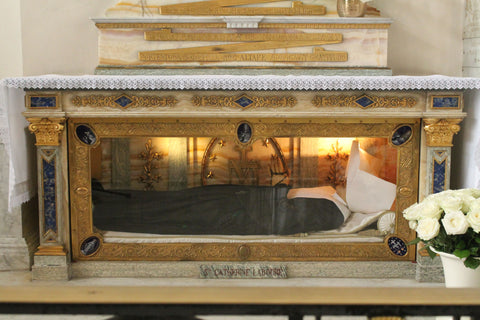In the quiet Chapel of the Daughters of Charity in Paris, an extraordinary story unfolds—a story that weaves together the miraculous events surrounding a humble nun and the power of a small, seemingly simple medal. This is the story of St. Catherine Labouré, the visionary of the Miraculous Medal, and the miracle of her incorruptible body.
It all began in 1830 when Catherine Labouré, a young novice, experienced a series of visions of the Blessed Virgin Mary. In these visions, Our Lady revealed to Catherine a medal with a unique design and profound symbolism. The front of the medal depicted Mary standing on a globe, rays of light streaming from her hands, with the words: “O Mary, conceived without sin, pray for us who have recourse to thee.” On the reverse, a large "M" surmounted by a cross, and below it, the Sacred Hearts of Jesus and Mary. Mary instructed Catherine to have this medal struck and promised that all who wore it with faith would receive great graces.
Catherine, driven by her deep faith and love for the Blessed Mother, shared this message with her confessor, who eventually helped her fulfill Our Lady’s request. The Miraculous Medal, as it came to be known, quickly spread across the world, becoming a powerful sacramental and a source of countless miracles and conversions.
Yet, Catherine remained unknown to the public, her identity concealed for nearly 46 years after the apparitions. She lived a life of quiet service and humility in the convent, never seeking recognition or fame. It wasn't until shortly before her death that she revealed herself as the visionary. She passed away on December 31, 1876, having lived a life of silent obedience and unwavering faith.
But the story did not end there. Nearly 57 years after her death, in 1933, her body was exhumed as part of the process for her beatification. To the astonishment of all present, Catherine Labouré’s body was found to be incorrupt—completely preserved, as if she had just fallen asleep. Her flesh was still supple, her face serene and untouched by time. This miraculous preservation was seen as a divine testament to her holiness and the truth of the apparitions.
Many believe that the incorruptibility of Catherine Labouré’s body is directly linked to the grace and power of the Miraculous Medal. The medal, designed by heaven and given to the world through Catherine, has been a channel of divine grace and miracles. Catherine’s incorrupt body is seen as a miraculous sign itself—a testament to the medal's efficacy and the truth of Our Lady’s promises.
Today, St. Catherine Labouré’s incorrupt body lies in a glass coffin beneath the side altar of the Chapel of Our Lady of the Miraculous Medal in Paris, where countless pilgrims come to pray, to seek graces, and to witness this enduring miracle. They come wearing their Miraculous Medals, holding them tightly, praying with faith and hope, just as Catherine did in her life.
The story of the Miraculous Medal and the incorruptible body of St. Catherine Labouré continues to inspire and draw people closer to Mary, the Mother of God. It is a story of divine grace, unwavering faith, and a heavenly promise that still echoes through the centuries: “O Mary, conceived without sin, pray for us who have recourse to thee.”

